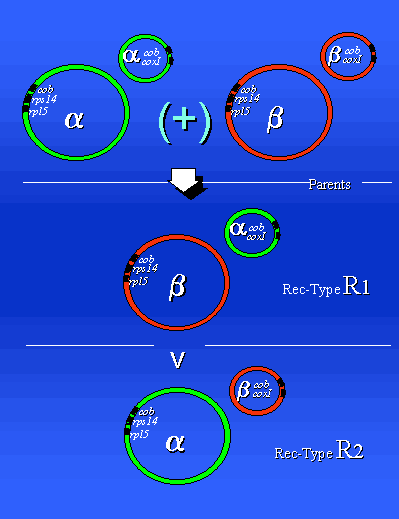Model of Mt Genome Rearrangements
- Types a and b and recombinant hybrid mt genomes R1 and R2.
Probe m100 has shown new rearrangements, which affect simultaneously the gene rps14 and copies of the cob (next to rps10 and coxI) gene. After protoplast fusion parts of mitochondrial genome type a are replaced by subgenomes from chondriome type b and vice versa. Fusion hybrids with deviating mitochondrial types show a recombinant pattern. R1 and R2 have no cleavage sites for the recombination event. The different parental mt subgenomes are not necessary integrated in the main genome. They can be exchanged independently from the other genome parts

In view of the various chondriome types
observed within a potato fusion hybrid population the parental and progeny
mt genomes are supposed to be organized in a manner similar to the schematic
model given in the figure. The mixtures and partial additions give an indication
for exchanges of mt genome units which appearently exist in shape of subgenomes.
Somatic hybridization combines a and
b mt subgenomes to
a new composition. This form of organisation could explain the new constitution
of hybrid types R1 and R2 and it could also explain the mixtures between
different loci which can be found in some hybrids. But a precondition for
this preliminary model is a multipartite structure of the potato mt genome
Back to "3 Levels of Differences"
Back to Home Page
Loessl: Cytoplasm Genome Research
Andreas LÖSSL, 15.10.2010